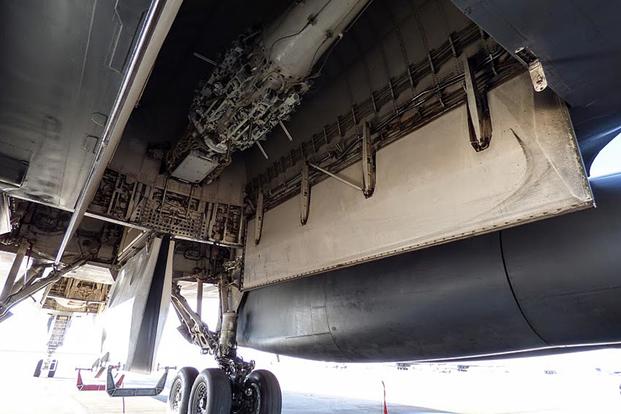DYESS AIR FORCE BASE, Texas -- The B-1B Lancer already can carry more weapons than its Air Force bomber counterparts.
But thinking about future airmen who will have to deploy and put bombs on target, leaders are hoping the B-1B Lancer get a scheduled upgrade to its bomb racks.
The main reason? So it can carry more than it already does.
"We have the largest payload, we have the speed to get to where we need to get to, we have the loiter time to hang out once we're there," said Lt. Col. Dominic "Beaver" Ross, director of operations for the 337th Test and Evaluations Squadron here at Dyess Air Force Base, Texas.
Related content:
- B-1B Aircrews Preparing for Return to the Middle East
- START Lanced the B-1's Nukes, But the Bomber Will Still Get New Bombs
- US B-1B Bombers Conduct First Nighttime Drills With Pacific Allies
The 337th, umbrellaed under both the 53rd Test and Evaluations Group, Nellis Air Force Base, Nevada, and the 53rd Wing at Eglin Air Force Base, Florida, conducts test and evaluations for all B-1 offensive and defense systems.
Military.com sat down with Ross during a trip to the base, and took a ride Tuesday in the B-1B over training ranges in New Mexico.
The aircraft's method of dropping bombs needs work, he said.
"We are getting what's called a BRU-56, an ejector rack [modification] and there's safety reasons for why we're getting it, but it gives us capability," Ross said.
The long-range aircraft has three types of racks that it carries in each of its three bomb bays.
"Where that ejector rack mounts on that eight-carry launcher, it just bolts on there," Ross said. "Our conventional rotary launcher … is what we carry our [GBU-31] 2,000-pound weapons with. It has eight stations on it."
But "there was a failure rate on those ejector racks," he said without elaboration.
Aside from that, there's also a spacing issue. "The B-1 carries the most 2,000-pound [Joint Direct Attack Munitions], but we [have to] carry [fewer] 500-pound [Joint Direct Attack Munitions]," Ross explained.
When the aircraft was a nuclear platform, the BRU-56 was originally designed to carry nuclear weapons with 30-inch lug spacing, according to the program's solicitation posted on FedBizOps. But the mod calls for more variety in the ejector spacing.
"A modification and upgrade to the BRU-56 ejector rack on the Multi-Purpose Rotary Launcher (MPRL), to include 14-inch lug spacing capability, would contribute to increased safety, quicker sortie generation rates, lower maintenance time, increased reliability, and lower maintenance personnel requirements," the solicitation says.
The variation in ejector spacing is needed because GBU-38 500-pound weapons have tail kits "that are a little bit too long" for some of the carry-racks, Ross said.
Depending on whether the bombs are in the forward weapons, intermediate or rear AFT bay, there must be meticulous rearrangement so they can properly fit, he said.
"They won't fit on the upper station on the 10-carry rack," Ross said. "So it's funny because … we only carry 15 total, 500-pound JDAMs, but we can carry 24 2,000-pound JDAMs."
The BRU-56 modification will expand the rack to carry eight 500-pound JDAMs in each bay, "so it will [be able to] carry the same number [as] the 2,000-pounders," he said.
The upgrade may take awhile. The Air Force has only just started the bidding process, according to the FedBizOps post, which stipulates roughly three years time to design, develop and manufacture the upgrade.
Currently, the B-1 can carry 75,000 pounds -- 5,000 pounds more than the B-52 Stratofortress -- of both precision-guided and conventional bombs.
Those bombs include Mk-82 or Mk-84 general-purpose bombs; Mk-62 or Mk-65 Quick Strike naval mines bombs; cluster munitions such as the CBU-87, -89, -97 or Wind-Corrected Munitions Dispensers such as the CBU-103, -104, -105; GBU-31 or GBU-38 JDAMs; AGM-158A Joint Air-to-Surface Standoff Missiles; and GBU-54 Laser Joint Direct Attack Munitions.
-- Oriana Pawlyk can be reached at oriana.pawlyk@military.com. Follow her on Twitter at @Oriana0214.










